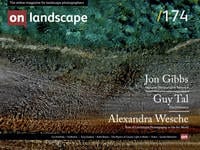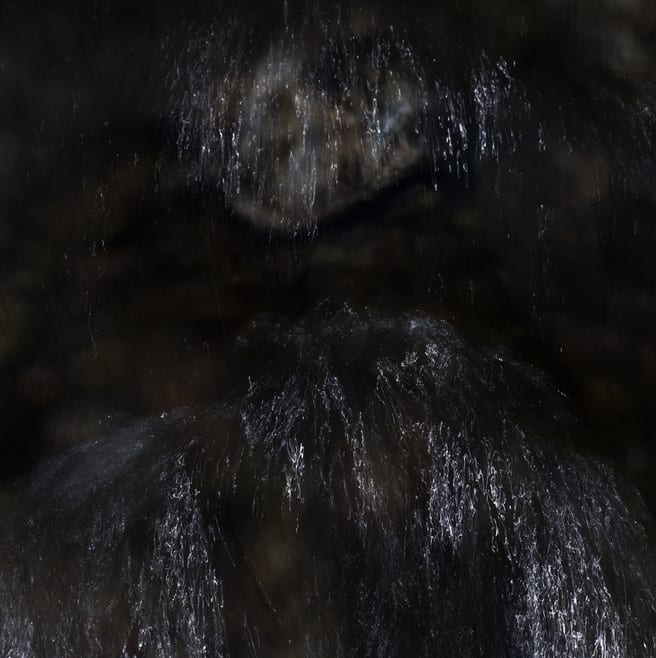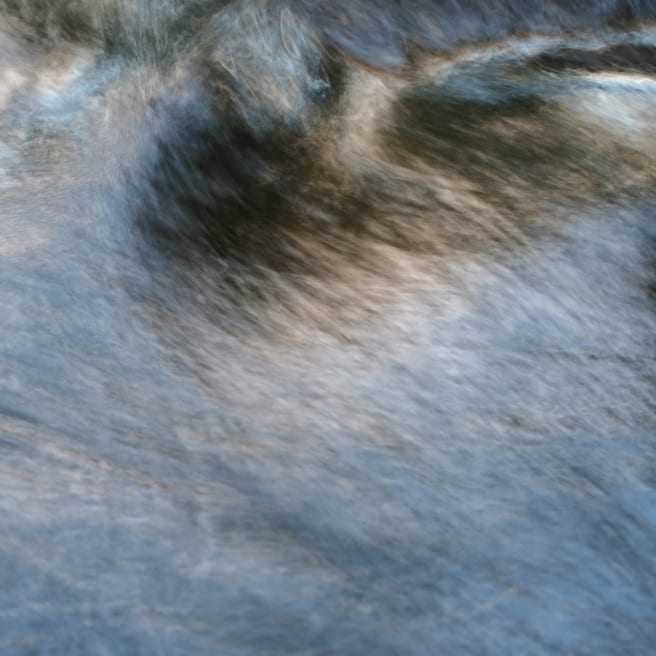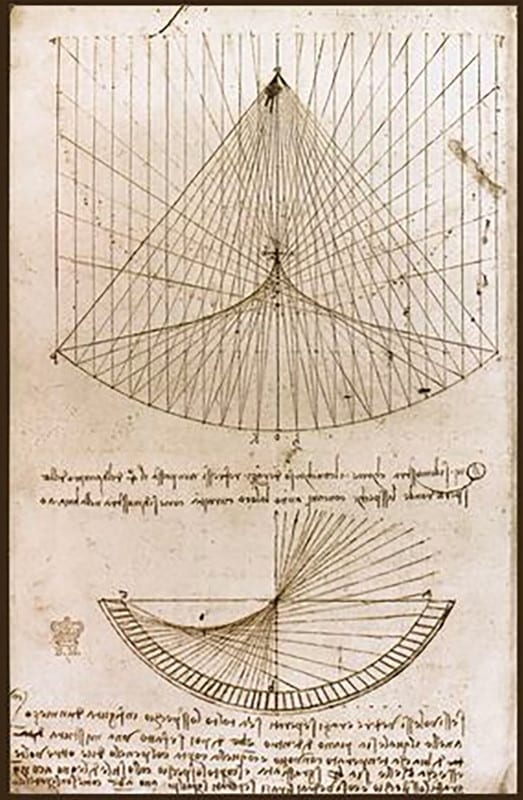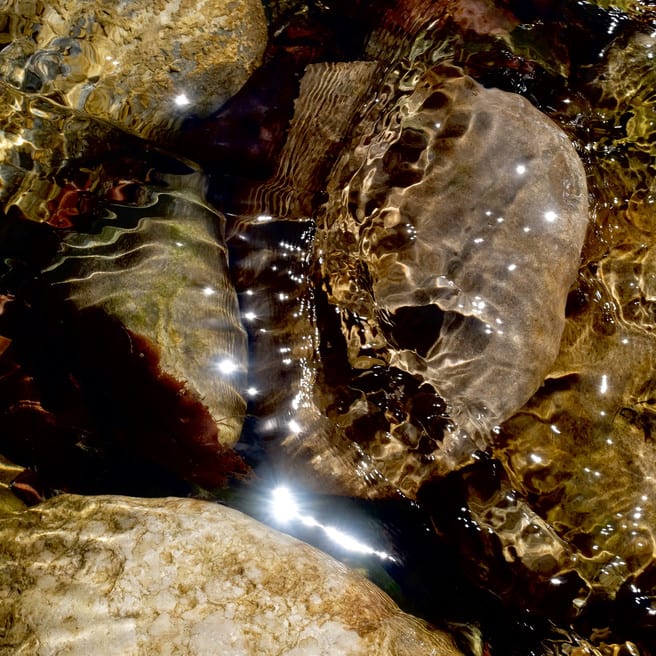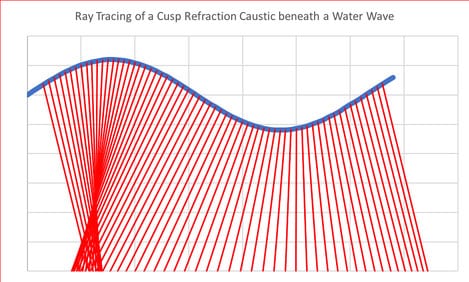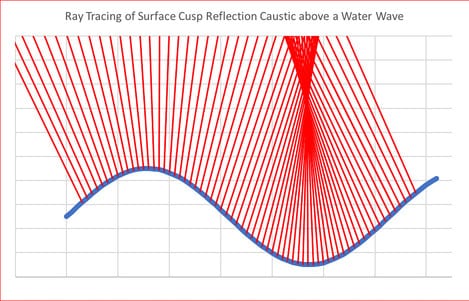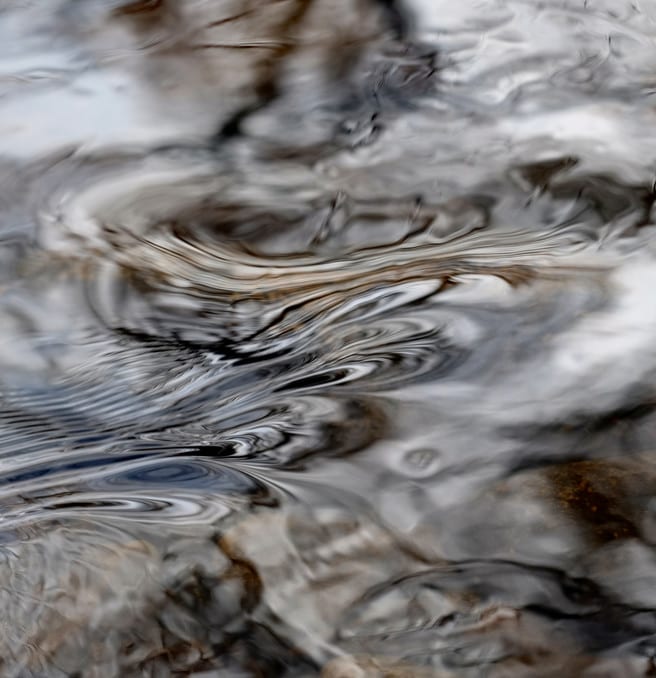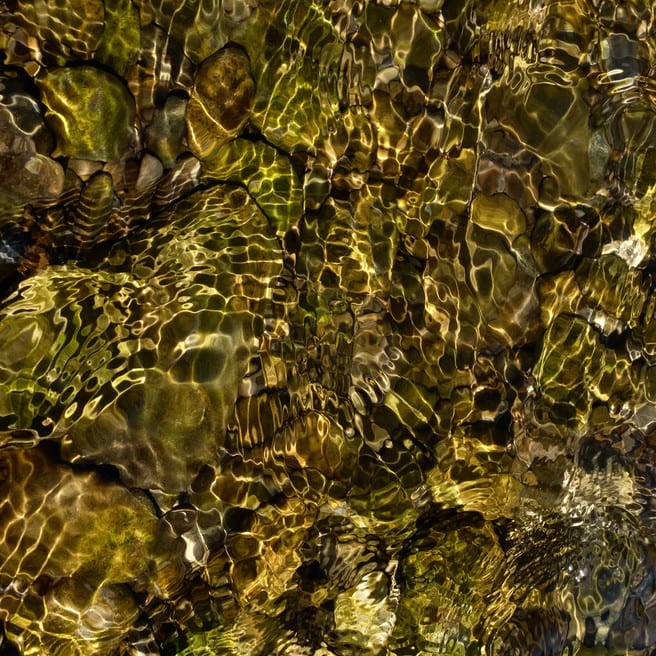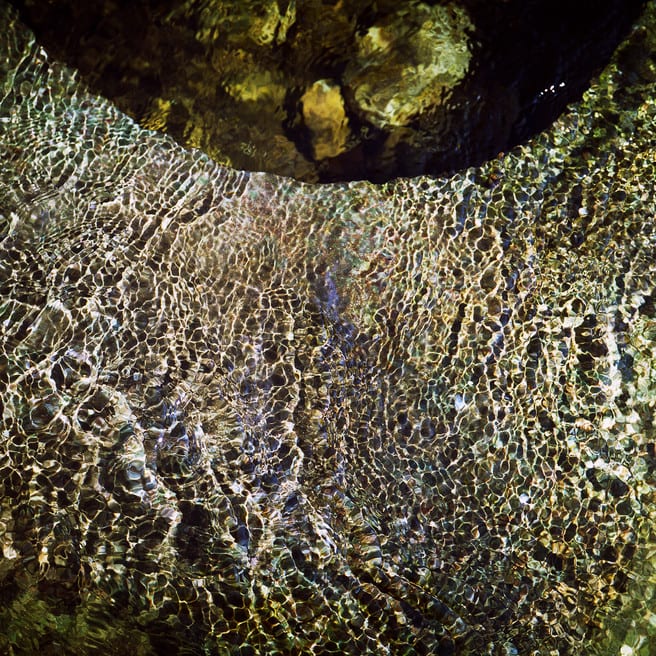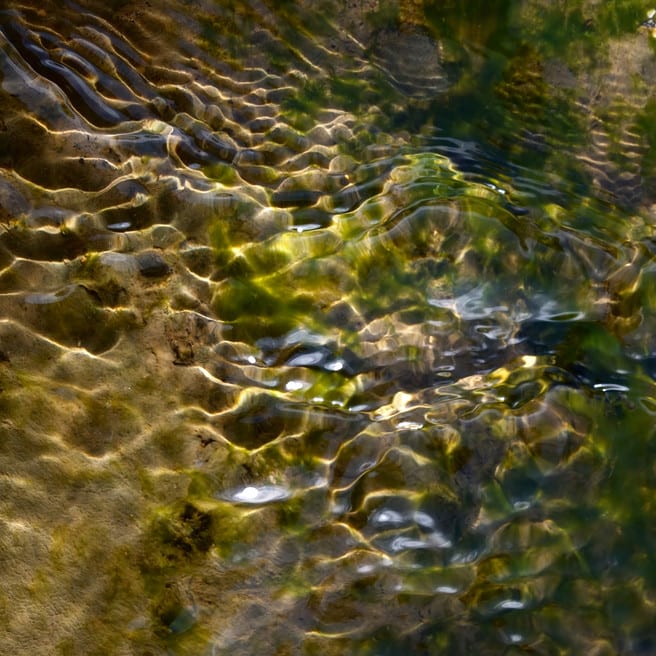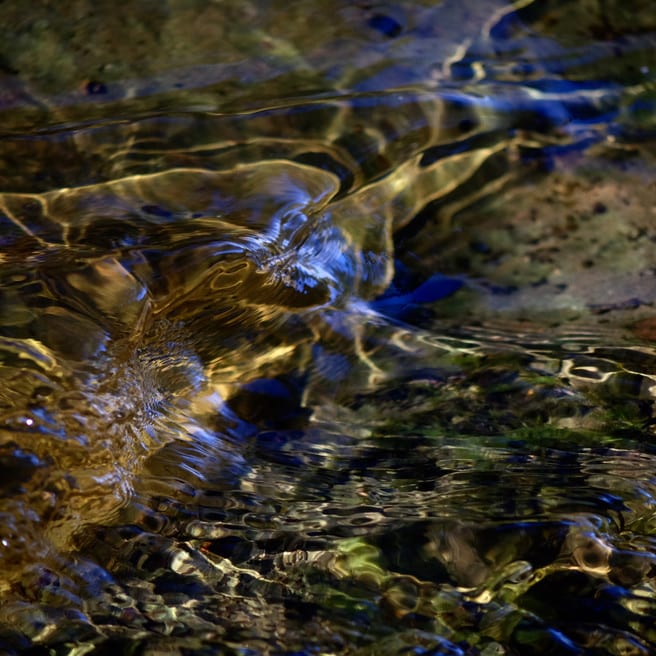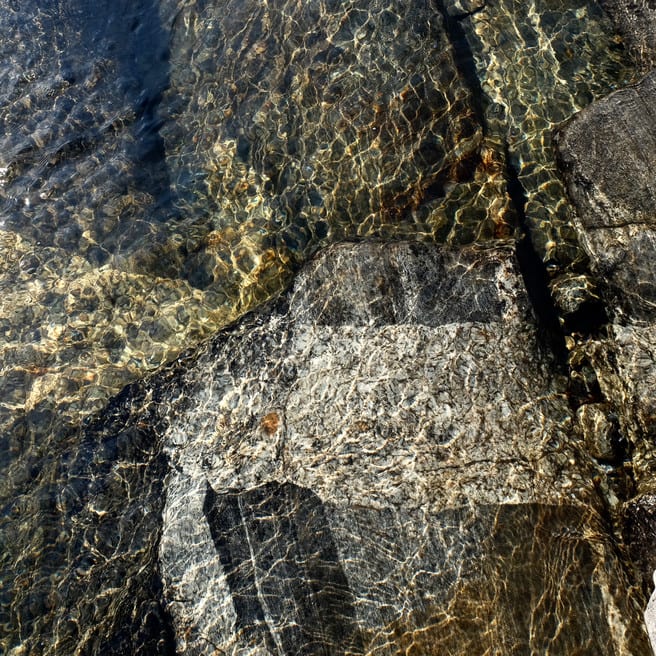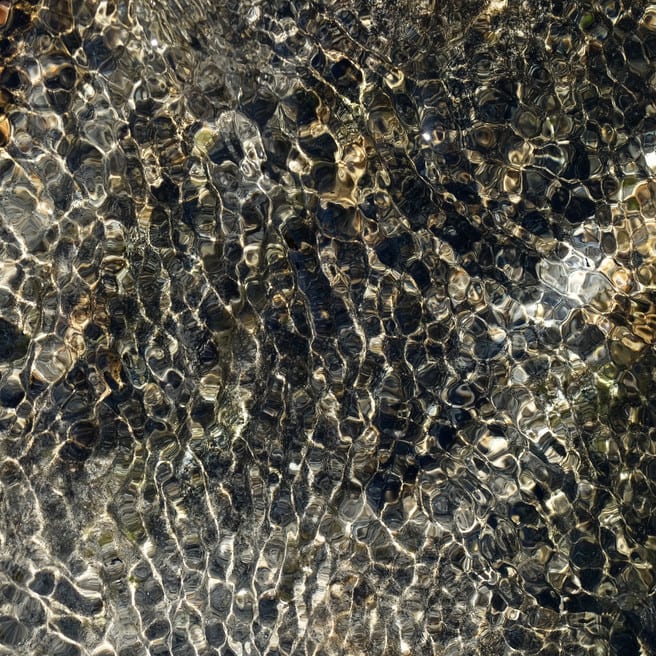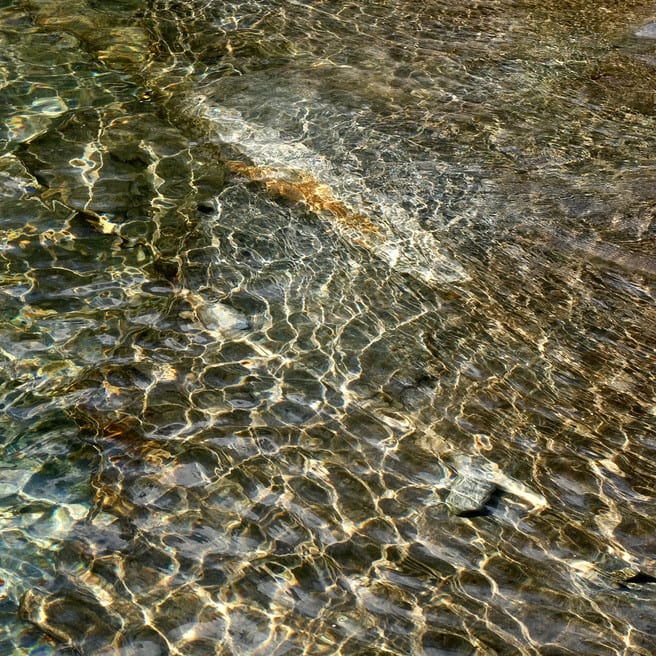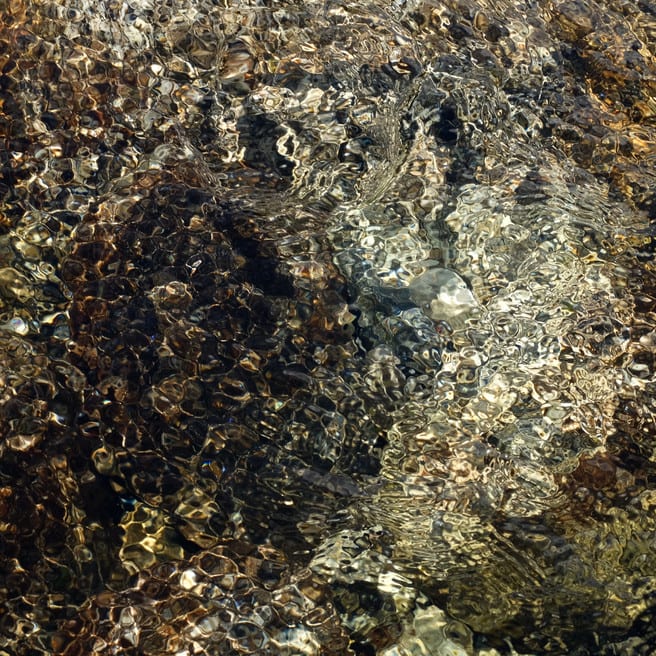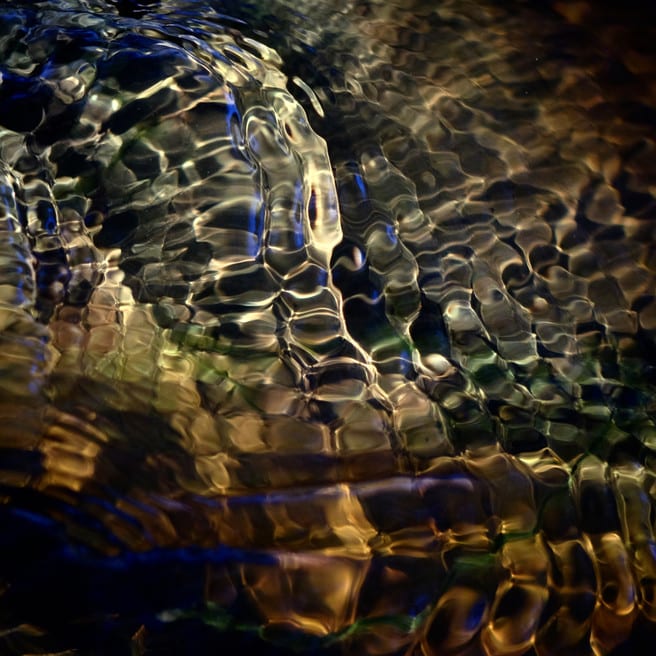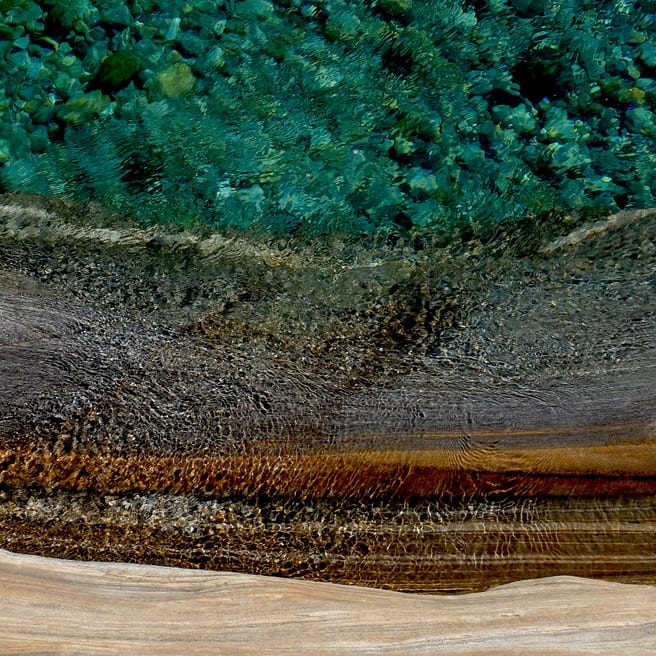The interaction of light and flowing water

Keith Beven
Keith Beven is Emeritus Professor of Hydrology at Lancaster University where he has worked for over 30 years. He has published many academic papers and books on the study and computer modelling of hydrological processes. Since the 1990s he has used mostly 120 film cameras, from 6x6 to 6x17, and more recently Fuji X cameras when travelling light. He has recently produced a second book of images of water called “Panta Rhei – Everything Flows” in support of the charity WaterAid that can be ordered from his website.
Now the fact is that there is hardly a roadside pond or pool that has not as much landscape in it as above it. It is not the brown, muddy, dull thing we suppose it to be; it has a heart like ourselves, and in the bottom of that are the boughs of the tall trees and the blades of the shaking glass, and all manner of hues of variable pleasant light out of the sky. ~John Ruskin, Modern Painters.1
As will be all too evident from my previous articles for On Landscape2, I like to make images of water in its various forms, but particularly the interaction of light and flowing water in streams and rivers. The attraction in making many of these images is often the points and lines of concentrated light that make the surface sparkle (and, of course, makes deciding on an exposure difficult!). We can sometimes use these points and lines with a slower shutter speed to give an indication of the movement of the water (see Sarine at Hauterive Caustic Traces below), or blur them out over a second or more to create more abstract patterns (see Eden at Shoregill Abstract below). Those points and lines of bright light are called caustics3 . We may have some vague ideas that they are caused by the effects of refraction and reflections in the flowing water. That is indeed the case, but caustics turn out to be a really interesting physical phenomena that have impact in a wide range of domains from dark matter and gravitational lensing around stars, to sound (the “whispering gallery” effect), understanding the ionosphere, non-destructive testing, and the interpretation of remote sensing images. From a photographer’s point of view, they are also important in how we see the rainbow, mirages, and the interaction between curved architectural glass and light.
Caustics may be defined as the envelope of light rays that have been reflected or refracted from a curved surface and projected onto a surface where they can be visualised.
This is not actually new, the first known drawing of such a caustic ray tracing is actually by Leonardo Da Vinci (that man again!) and dates from around 1508. Leonardo’s drawing is similar to that we see when sunlight is reflected from the side of a teacup onto the surface of the tea in it. Other common examples are the often complex patterns of light passing through a glass of clear water onto a tabletop, and the patterns on the surface of a swimming pool when the surface is disturbed, as famously represented in the “Underwater Swimmer” image of André Kertész from 19174 and some of the Californian pool paintings of David Hockney. Sometimes we will see both the surface caustic and its reflection from the bottom of the pool or stream. With modern computational algorithms, it is possible to do ray tracing for a wide variety of complex lighting situations, including the generation of caustics in rendering surface water surfaces5. It is even possible to “reverse engineer” caustics. Work at EPFL at Lausanne in Switzerland has shown that a specially designed acrylic sheet can be used with a light source such that the resulting caustics give a clear image on a surface (they reproduced a photographic portrait of Alan Turing in their demonstration).
Rainbows are another nice example of caustics at work. We all learned at school how rainbows result from the refraction of light and internal reflection in raindrops. Since different wavelengths of light are refracted by slightly different angles6, incoming sunlight is split into the spectrum of visible wavelengths and the resulting rainbow will be seen most clearly when the observer is at 42° to the direction of incoming light from the sun, especially if there is a large black cloud in just the right place for a good photo possibility….. In fact, most rays of light pass through the raindrops with little impact; it is only those that cross on leaving the drop that creates a caustic to give the intensity of the colours and the clean separation at the edges. The caustic surface or caustic sheet separates the region where rays of light cross and the light is concentrated, from those where they spread giving a darker region.
There is a whole book devoted to caustics by John Nye, Professor of Physics at Bristol University (he is also an expert on the structure and properties of ice and glaciers)9. His latest scientific paper, published this year, is on Symmetrical Optical Caustics (note that Prof. Nye was born in 1923!). In his book, he notes that the study of caustics and the diffraction phenomena associated with them has revolutionised the study of optics, with a mathematical foundation being laid down by the developments in catastrophe theory by the French mathematician René Thom and others. A caustic surface is effectively a form of separating surface analogous to the catastrophe surfaces in the theory.
With the advent of catastrophe theory it is realised that there is hitherto unsuspected organisation in such patterns….. Nature also has its way of focussing light, but it is rather different. In nature there are few approximations to point foci; those that do occur are mostly in the eyes of animals, where nature has been aided by biological evolution. Rather, when light from a distant source passes through a refracting medium the natural result is the concentration of rays on to bright caustic surfaces. Even when the light is monochromatic, closer examination reveals that the caustics are not perfectly sharp but are softened by being decorated with characteristic diffraction structure…. Thus there is a whole spectrum of scales to be explored, with each increase in resolution revealing new structure.~ John Nye, preface to the book
Nye shows that at the macroscopic level (much greater than the wavelength of light), the scale at which we normally photograph, the stable objects are the caustics. There is a theorem from Thom that proves that there are only five distinctly different forms in up to three dimensions10. At finer scales, each of the five caustic forms has its own diffraction pattern, providing structure as the magnification increases (see Sarine at Hauterive: Bright Stars below, where there is a diffraction fringe around the main caustic).
In 1977, Michael Berry, one of Nye’s colleagues at Bristol had shown that these fine scale patterns can be fractal in nature, with all the rich complexity of structure that implies. Berry and Nye identified a problem, however, in that many caustic patterns in water show triple junctions that do not appear in the simple catastrophes. This was explained in the later work by Upstill11 who showed the complexity of caustic patterns that could arise by having two sets of surface waves intersecting at an angle. Such waves can be generated by the wind or other disturbance, and wave reflections from a boundary (such as in a swimming pool) or the turbulent vortices generated over a rough stream bed. Fractal optics is now a subject area in physics in its own right but the fine scale structures will generally be invisible to the macroscale photographer. What we can see are the caustics (and perhaps some lens diffraction) and their changing patterns over time. Nye has shown that small dynamic perturbations can result in changing patterns, albeit based on the same basic forms.
For the macroscopic caustics, we can use ray tracing to try to visualise the type of patterns we might expect in shallow water for a simple case with some waves on the surface, lit by the sun directly overhead. This can lead to some caustic sheets beneath each waveform as a result of intersecting refracted rays in the water (diacaustics), and to reflection caustics (catacaustics) when the waves are at just the right angle to reflect light to the eye or camera lens. Reflection also results in the light being polarised, which is why a polarizing filter can be so effective in reducing glare from water surfaces. These two situations are demonstrated using ray tracing in the figures for refraction and reflection, but it is necessary to remember that what the eye or lens sees will be only the rays reaching their small aperture to be recorded by whatever sensor lies behind it. Thus for the case of refraction caustics, we will normally see the light scattered from the caustic by the bed back towards the eye (and refracted again as it leaves the water).
Movement of the surface waves through which the light is passing will cause the forms of the caustics to persist but the location to shift. In some cases, small scale perturbations of the moving surface will mean that specular highlights can appear and disappear at the same place. This can give the appearance of sparkling on the surface. The situation in shallow water can be further complicated by caustics resulting from the reflection of rays from an irregular bottom surface interacting with other rays. Full sun on a water surface can, therefore, exhibit a number of different types of caustics, due to reflection, refraction from the surface and reflections from the bed that might all be seen in an image. These will be the bright highlights in the image, but there will also be colour, a result of reflections of the sky and surroundings from the water surface (sometimes called skypools and landpools12) and illumination of the bed (at least where the water is clear enough).
The images below represent the sum of all these effects. There are different types of caustics and reflections shown. Caustic highlights are sometimes playing across the surface as both points and patterns. Surface reflection caustics tend to lie in the depressions in the surface, where rays of reflected light will cross and concentrate the reflected light. This can occur between linear ripples on the surface. Refraction can lead to dynamic grid like patterns crossing the stream bed induced by the undulations in the water surface above.
Colours are a mix of reflected light and the transmitted colours of the bed materials. Larger patches of white highlight will generally be from the reflected sky rather than caustic sheets. Some colour fringing associated with the caustics can also sometimes be seen (see Eden at Stenkrith: Refraction Caustics and Edge of Pothole). This is a form of strong chromatic aberration resulting from the wavy surface acting as a rather poorly designed lens. Refraction causes the focusing of different wavelengths at different points on the exit ray pathways towards the eye. It is perhaps a little ironic that something that we would normally wish to avoid in purchasing a lens, can be rather attractive in an image of a water surface.
Exposure of caustics in these images can be difficult. Exposure to the right so as to avoid clipping of caustics can result in underexposure of the rest of the image using both film and digital sensors. After all, they represent concentrated light. When the highlights are moving, a slower shutter spread can spread the load across the sensor area. This can be advantageous in getting streaks of highlights to focus attention on the dynamics of the flow; it can be disadvantageous in smearing patterns of highlights unless aiming for a more abstract pattern of colours. Aperture can also be important, since the smaller the aperture then the greater the effects of diffraction (something than can also be used to good effect in producing sunstars). Exposure is usually, therefore, some form of compromise and acceptance of some clipping. Film tends to handle such highlights with smoother transitions but the increasing dynamic range of newer digital sensors is making it easier to bring back underexposed areas.
Even after many years of experience, these types of water images remain an experimental process. Sometimes they work, sometimes not. The advantage of digital in that respect is that there can be immediate feedback on the choice of aperture, shutter speed, ISO and any filters used. Having said that, some of my favourite images have been taken on film, particularly Fuji Reala when it was still available (Eden at Stenkrith: Refraction Caustics and Edge of Pothole is one). I am, however, happy that the challenge is still there and will keep me occupied for still more years to come.
References
[1] Quoted in M. G. J. Minnaert, 1993, Light and Color in the Outdoors, (English edition), Springer; originally published in Dutch in1937, with a 5th edition in 1968, with some modifications arising from an earlier translation into Finnish!
[2] See https://www.onlandscape.co.uk/2017/04/the-science-and-art-of-hydrology/ and https://www.onlandscape.co.uk/2017/12/the-impact-of-photography-on-impressionism/
[3] after the Greek word for burnt, as in the focusing of light by the lens of a magnifying glass.
[5] See, for example, Foley et al., 1996. Computer Graphics: Principles and Practice, 2nd ed. Addison-Wesley.
[6] Perhaps you remember Snell’s law of refraction? That dates from 1621 though Michael Berry in his 2015 paper on Nature’s Optics in the journal Contemporary Physics points out that this law was derived independently by Descartes in his 1638 explanation of the rainbow (but with some wrong underlying assumptions), was known to Harriot in 1602 well before Snell, and to Ibn Sahl some 500 years before that!
[7] Diffraction is the bending of light around a sharp edge or through a small aperture as the result of interference in the wave like nature of light, resulting in dark and light banding. The effect depends on the wavelength of the light and the size of the aperture (hence the longer arms of sunstars when a lens is set at small apertures). It occurs with all types of waves, including waves on a water surface.
[8] Michael Berry’s paper is worth looking up as it contains a fine photograph by Roy Bishop of a bright rainbow, secondary rainbow and supernumary diffraction rainbows curving over the birthplace of Isaac Newton. Nothing like being in the right place at the right time with a camera to hand! He points out that this is somewhat ironic in that Newton was not able to explain the supernumary rainbows in his optics. The effects were known at that time due to the work of Grimaldi but Newton suggested that they were due to the inflexion of the paths of the light rays. A full explanation required the wave theory of diffraction which came later, particularly after the work of Thomas Young in 1803 and Augustin-Jean Fresnel in 1825 (he of the Fresnel lenses used in focusing screens and to reduce the length of telephoto lenses).
[9] J. F. Nye, 1996, Natural Focusing and Fine Structure of Light: Caustics and Wave Dislocations, IOP Publishing. There is a transcript of an interview with John Nye as part of the British Library’s National Life Stories archive at https://sounds.bl.uk/related-content/TRANSCRIPTS/021T-C1379X0022XX-0000A0.pdf
[10] These are the fold, the cusp, the swallowtail, the elliptic umbilical, and the hyperbolic umbilical (see Nye’s book or the chapter on Natural Focusing by Michael Berry in The Artful Eye edited by Gregory et al., Oxford University Press, pp 311 – 323). There are some nice illustrations of various forms in Berry and Upstill, Catastrophe Optics: Morphologies of caustics and their diffraction patterns, that can be found at https://michaelberryphysics.files.wordpress.com/2013/07/berry089.pdf
[11] C. Upstill, 1979, Light caustics from rippling water, Proc. Royal Society, A365: 95-104
[12] See David K Lynch and William Livingstone, 1995, Color and Light in Nature (2nd Edition), Cambridge University Press, Section 3

